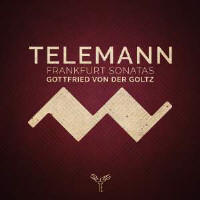Texte paru dans: / Appeared in: |
|
|
Reviewer: Raymond
Tuttle
These so-called “Frankfurt
Sonatas” have been recorded several times in recent years. They were
published in that city in 1715, where Telemann had been living for three
years, after leaving Eisenach. In Frankfurt, he was less subject to the
whims of noble employers, although as Music Director of two churches he
still was a very busy man.
The title page of the
published sonatas specifies that they are for “Violon seul, accompagné par
le Clavesßin,” and that they are dedicated to Prince Joachim Ernst IV of
Saxon-Weimar. Annotator Martin Bell writes, “In the early eighteenth
century, works featuring a solo instrument and harpsichord (keyboard
instrument) without the obligatory (but charming) use of the cello are not
common, even for Telemann.” Why this recording includes additional
instruments anyway we are not told ... and it appears that no one told Bell,
either. It would be inconsistent or even hypocritical for me to complain too
loudly that these musicians do not play these works as Telemann apparently
intended them to be played. Even so, there are listeners who will want to be
aware of the ensemble’s size before making the decision to acquire this
disc.
In terms of whether these are
church sonatas or chamber sonatas, they are neither fish nor fowl. All six
are in four movements, beginning with a slow movement, and this is typical
of church sonatas. On the other hand, half of the sonatas have movements
that are named after dance genres (allemanda, sarabande, corrente, and giga),
and this is more typical of chamber sonatas. The progression of keys
suggests that Telemann did not assume that they would be performed as a set
of six, or at least in a fixed order. Stylistically, German, French, and
Italian styles are represented in these sonatas, which is no surprise for
Telemann, who had catholic tastes, and who knew how to satisfy his
listeners’ desire for novelty and variety. As I wrote at the outset, there are other recordings of these works. The one that I know best is by violinist Valerio Losito and harpsichordist Federico Del Sordo (Brilliant Classics, and reviewed in Fanfare 40:6 by Robert Maxham). To cut to the chase, I find it much superior to Aparte’s effort ... and “effort” really is the correct word, because von der Goltz and colleagues often give the impression that they sweated over each and every note. The slower movements, in particular, sound labored and are additionally marred by the sound of von der Goltz’s violin, which is pinched and acidulous. Overall, it is no joy to hear, and his fellow musicians do little to chase the bad taste out of my mouth. Maxham wrote that Losito and Del Sordo are “strongly recommended,” and I concur. They bring out the melodious nature of these sonatas, and their frequent outbursts of joy. I hear no reason to prefer what I am hearing in this new recording.
| |
|
|
|
|
|
|
|
Cliquez l'un ou l'autre
bouton pour découvrir bien d'autres critiques de CD |
|




